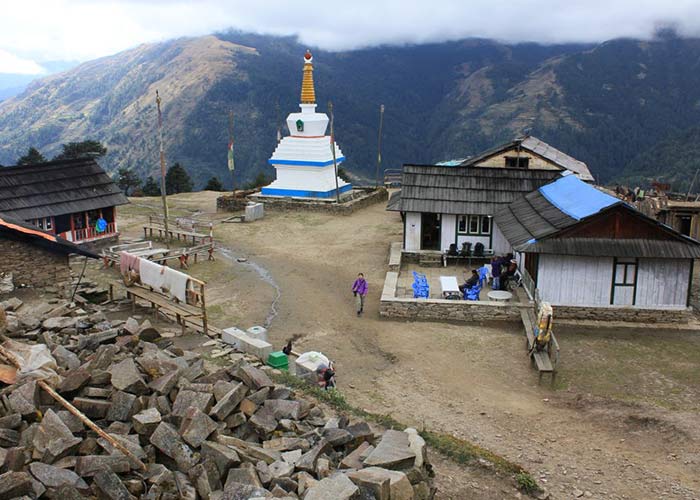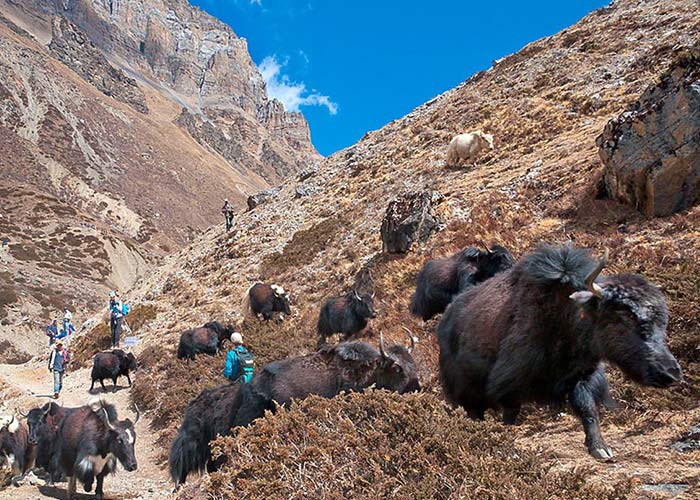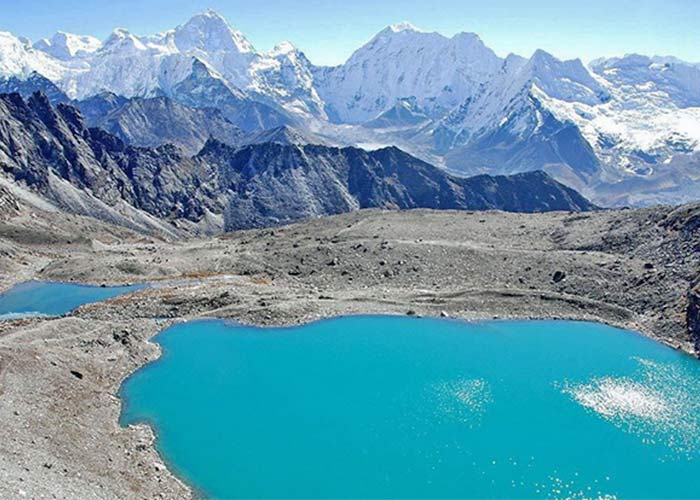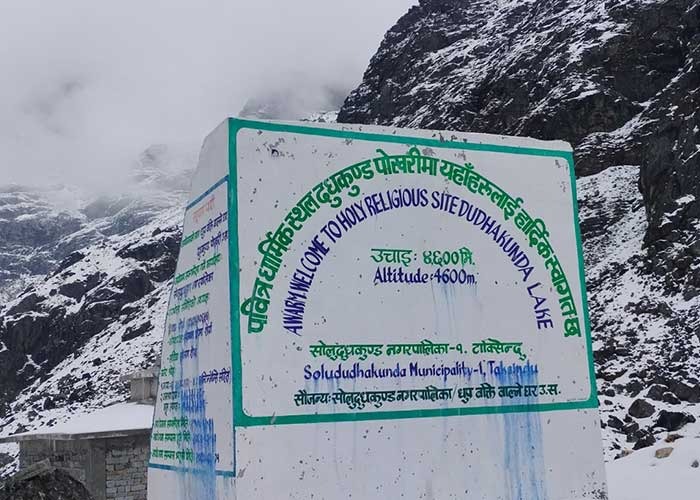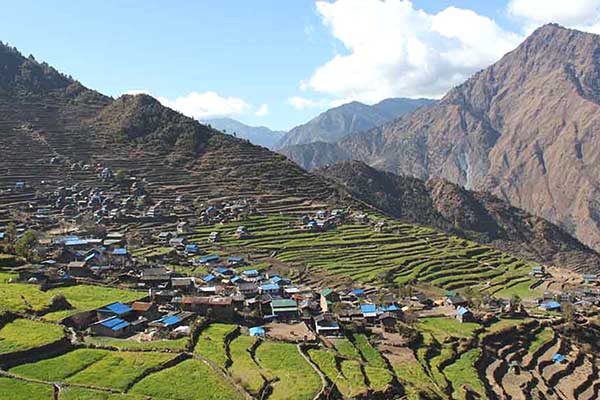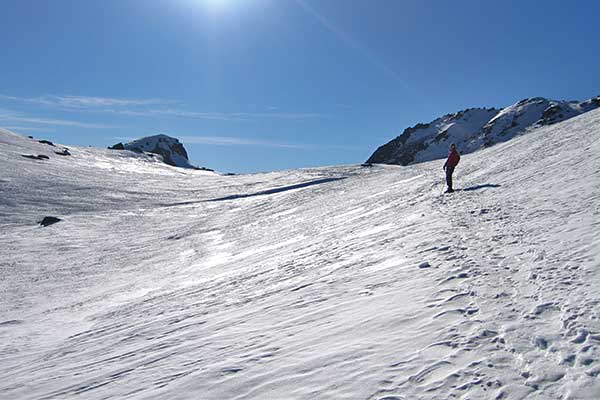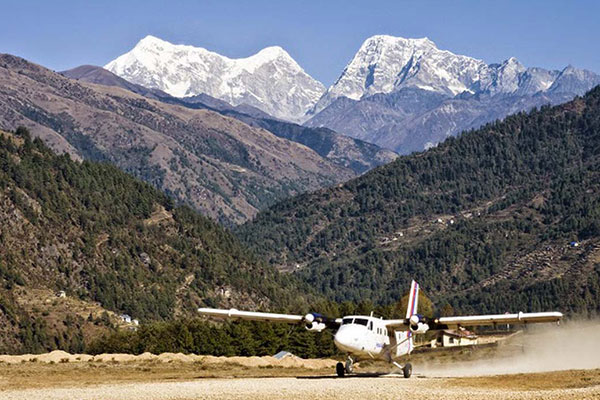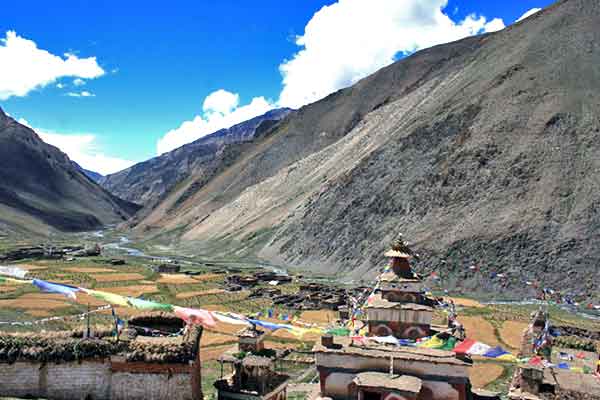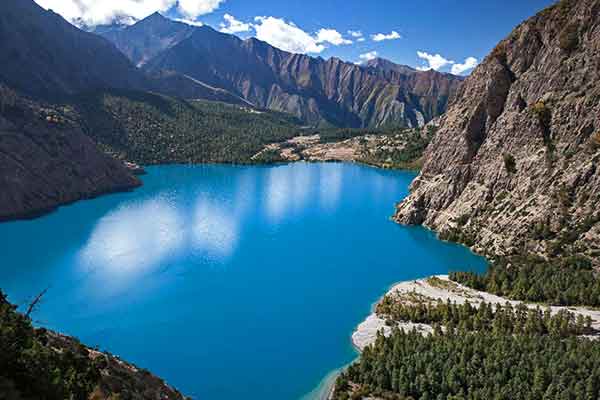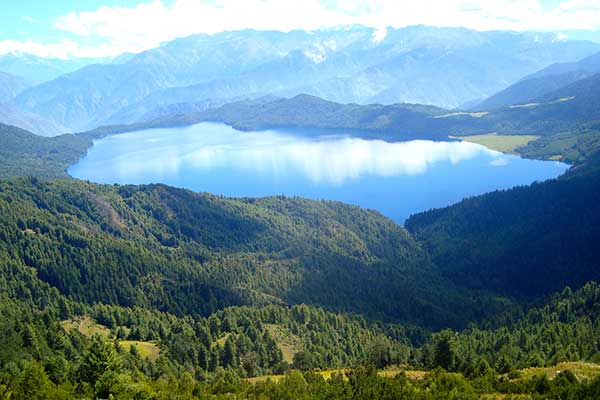Overview
Duration :
14 Days
Secondary Activity:
Nature and Culture
Max altitude :
4,561m/14,963 ft
Transportation:
Private Vehicle
Trip ends in:
Kathmandu
Accomodation:
Hotel and Lodge
Primary activity:
Trekking and Hiking
Group Size:
Min. 2 pax
Country:
Nepal
Trip starts from:
Kathmandu
Diffficulty:
Strenuous
Meals:
Nepali and Continental
Best Season:
Autumn and Spring
Trip route:
Kathmandu-Shivalaya-Bhandar-Sete-Junbesi-Thuptenchholing Gumba- Yak Kharka-Dudh Kunda-Saharsbeni-Taksindu-Paplo- Kathmandu
Trip introduction
Dudh Kunda Trek offers us a different trekking perspective at lower elevations of the Everest region in Nepal. Dudh Kunda Trek offers a great view of snow-capped mountains along with plenty of insights into local Sherpa culture, tradition, and lifestyle. They are well known all around the world as unsung heroes of Everest and also for their hospitable nature. These trails are also known as monastery trails as there are plenty of those and we never miss an opportunity to visit along our Dudh Kunda Trekking trail.
Journey: Dudh Kunda Trek
Our culturally affluent camping and/or Dudh Kunda Trek starts after we complete our Kathmandu sightseeing and necessary trek preparations. Initially, we drive from Kathmandu to Shivalaya which is also the starting point of our Dudh Kunda trekking. The Dudh Kunda trekking trail takes you all the way through the ancient trading routes in the Everest region.
Narrow ridges, crossing the river valleys, beautiful Rhododendron forests with floras and faunas like Himalayan Thar, Leopard, Jackal, and Pheasant up to Dudh Kunda. Dudh Kunda Lake also offers excellent views of the highest Himalayas standing tall in the Everest region. From Dudh Kunda, we make our way through Saharsbeni, Taksindu, and Phaplu and fly back to Kathmandu concluding our amazing journey. After arrival in Kathmandu, we can go souvenir shopping or just rest and relax at our hotel.
Physical Fitness and Best Season
Dudh Kunda Trek is suitable for any travel lover without any risks of high altitude sickness as the maximum altitude gain is 4,561m above sea level at Dudh Kunda which should be normal. However, we recommend you practice some cardio exercises to make yourself physically and mentally fit before the trip. So that you can make the most out of it. Months of September, October, November in autumn, and March, April, and May in spring are the best seasons for this trip.
Join this amazing monastery trail with Nepal Mountain Trekkers for professional travel arrangements and services. Contact us now for booking and further information. And grab the special discount we are offering on this trek to promote tourism in Nepal for the year 2025.
Special Note:
If this itinerary doesn’t suit your requirement or if you want to customize it, please feel free to contact us. This trek could be customized as per your required time frame and budget limits.
Overview
-
Day 1Arrival in Kathmandu:
-
Day 2Kathmandu Sightseeing and Trek Preparation:
-
Day 3Drive Kathmandu to Shivalaya (1,770m/5,807ft):
-
Day 4Shivalaya to Bhandar (2,190m/7,185ft) via Deurali:
-
Day 5Bhandar to Sete (2,800m/9,186ft):
-
Day 6Sete to Junbesi (2,700m/8,858ft):
-
Day 7Junbesi to Thuptenchholing Gumba:
-
Day 8Thuptenchholing Gumba to Yak Kharka:
-
Day 9Yak Kharka to Dudh Kunda (4,561m/14,963ft):
-
Day 10Dudh Kunda to Saharsbeni (3,835m/12582ft):
-
Day 11Saharsbeni to Taksindu (2,960m/9,711ft):
-
Day 12Taksindu to Phaplu (2,470m/8,103ft):
-
Day 13Fly Phaplu to Kathmandu:
-
Day 14Departure Day:
Detail Itinerary
Day 1 : Arrival in Kathmandu::
Upon your arrival at the Tribhuvan International Airport in Kathmandu and after clearing immigration and customs, you shall be welcomed by a representative of Nepal Mountain Trekkers who shall transfer you to your respective hotel. After taking a rest for your jetlagged body, explore the immediate surroundings in the vibrant Thamel which hosts diverse shops, and hotels, and is a neighbor to some eminent historical buildings. Enjoy the authentic dinner in the evening and prepare for a sightseeing city tour tomorrow. Stay overnight in Kathmandu.
Day 2 : Kathmandu Sightseeing and Trek Preparation::
Today you shall enjoy a city tour in the medieval city of Kathmandu and explore the historical and ancient heritages of prominent value. In a guided tour that shall reflect the rich diversity of this nation, you shall pay a visit to the Buddhist holy places of Swayambhunath (also known as the Monkey Temple) and Boudhanath Stupas which are known for their religious importance, ancient monasteries, and unique cultural ensembles within the premises. Next on the list is the Hindu holy place of Pashupatinath Temple located at the bank of the holy Bagmati River which is one of the most revered pilgrimages all over the world. We shall also explore the rich heritage of Patan Durbar Square, a complex with the ancient royal palace, unique Krishna Temple, museum, resting places, and intricate carvings on the stones and wooden structures on the premises. After this exploration, we shall have an interaction with the trekking guide and get ourselves clarified on the issues related to the trekking. Stay overnight in Kathmandu.
Day 3 : Drive Kathmandu to Shivalaya (1,770m/5,807ft)::
Our trek commences today as we take a drive to Shivalaya. After a succulent breakfast at the hotel, you will be accompanied by our guide. Our vehicle maneuvers through the busy and noisy streets of Kathmandu, past the Newar-dominated towns of Banepa and Bhaktapur. The driving route follows the Bhote Koshi River all the way up to a Tamang village. From here, we drive alongside the Tama Koshi River until we finally arrive at Jiri. Owing to its splendid natural beauty, Jiri is often given the nomenclature of “Switzerland of Nepal” and is gradually becoming the start-off point for most of the treks in the Everest region. From Jiri, we head onward to Shivalaya which is our last destination of the day. The residents here comprise the ethnic mix of Gurungs, Sherpas, Brahmins, Magars, etc. Stay overnight at Shivalaya.
Day 4 : Shivalaya to Bhandar (2,190m/7,185ft) via Deurali::
Today we shall wake up early as we have to start hiking from today onwards. Our route today passes through the Shivalaya Police Checkpoint. The tail to Bhandar is marginally steep, and most part of it is embellished with rhododendron clusters. Surmounting the climbs and simultaneously enjoying the rhododendrons, we arrive at Deurali (2,387m) which offers a splendid view of Pike Peak. The local inhabitants of Deurali are mainly Sherpas and Tamangs. Our trail now goes down until we arrive at the settlement of Bhandar. Stay overnight at Bhandar.
Day 5 : Bhandar to Sete (2,800m/9,186ft)::
From Bhandar, we descend on a downhill route through dense forests, cross a few streams, and then pass by the small settlements of Dokharpa and Baranda. From here, the route climbs through the forests and winds down to the Surma River. We continue trailing through the Likhu River valley. After about 3 hours of walking, we arrive at the village of Kinja village (1,624m), where we halt for lunch. This village happens to be the business hub for Ramechap and Solukhumbu districts. Our trek now resumes along an uphill route, until we eventually arrive at the settlement of Sete. Stay overnight at Sete.
Day 6 : Sete to Junbesi (2,700m/8,858ft)::
We grab our breakfast and then resume our footy mission, walking up through the jungle. Most part of this walk is through the forest. We arrive at Lamjura Danda and halt for lunch. We have a pass ahead, so after some good energizing lunch, we begin to trudge up the steep route until we get to the top of the Lamjura La Pass (3,532m). From atop, enjoy the splendid views of the peaks like Gauri Shankar, Dudh Kunda, Mera Peak, etc. including the flowery vista of the flashy rhododendrons. After this scenic retreat, we descend from the pass to the Sherpa and Newar-dominated village of Junbesi. Stay overnight at Junbesi.
Day 7 : Junbesi to Thuptenchholing Gumba::
We shall begin the trek with breakfast from the settlement at Junbesi and start our beautiful section of this trek to Thuptenchholing Gumba. The trek today provides you with an opportunity to observe Sherpa culture and visit monasteries. Junbesi is one of the most beautiful Sherpa villages in the lower Solukhumbu region. It is rich in astonishing landscapes, cultural wealth, and hospitable Sherpa people. In addition to this, you will also experience lush green wilderness and a beautiful landscape. Stay overnight at Thuptenchholing Gumba.
Day 8 : Thuptenchholing Gumba to Yak Kharka::
In the trek today we trek along the winding trail through the pine and rhododendron forests, suspension bridges, culturally rich Sherpa villages, and the marvelous views of the mountains all along the trail to Yak Kharka. You walk through alpine forests. You get to experience lush green wilderness amidst beautiful landscapes with close-up views of silver peak mountains. Stay overnight at Yak Kharka.
Day 9 : Yak Kharka to Dudh Kunda (4,561m/14,963ft)::
Today you will see mountain glaciers, Lake Dudh Kunda, and the mountains closely. If you visit during August you can be part of a fair at the Janai Purnima ceremony which is one of the remarkable festivals of Nepal. Bird watchers will also see migratory aquatic birds during the rainy season. Stay overnight at Dudh Kunda.
Day 10 : Dudh Kunda to Saharsbeni (3,835m/12582ft)::
We get going along the steep route to the Dudh Kunda Base Camp. On reaching the base camp, we pay a visit to Dudh Kunda Lake, which literally means the milk pond. The lake is perched right at the bottom of Numbur Himal, locally known as Shorong Yul Lha, which in the local dialect means the “custodian of Solu Lake”. Hence, both, the mountains as well as the lake have a great religious significance. Huge numbers of Hindu devotees visit the lake to take a holy dip every year. From the base camp, we can relish the views of Dudh Kunda Peak, Numbur I & II, as well as Mera Peak. We then trek back to Saharsbeni. Today’s journey has been a combination of trek and pilgrimage. Stay overnight at Saharsbeni.
Day 11 : Saharsbeni to Taksindu (2,960m/9,711ft)::
On our trekking trail today we shall pass through Kaku and Basa to reach Taksindu where you are able to see some breathtaking panoramic views of mountain peaks, sparkling waterfalls, and tranquil lakes that will entice you to stop. As you continue on, you’ll pass through dense forests of rhododendron, the national flower of Nepal, which are in bloom from March to May. Also in the fall (September to December) when the weather is temperate and the skies are clear you can see these wildflowers in full bloom. Views of flora and fauna, as well as a variety of wildlife, will catch your attention but not slow you down. Stay overnight at Taksindu.
Day 12 : Taksindu to Phaplu (2,470m/8,103ft)::
We shall wake up early in the morning with the view of the majestic sunrise glaring onto the lands below. The hike will take about seven hours today as we need to reach Phaplu, where you shall get a flight back to Kathmandu. So today you walk through mixed alpine forests, experience wildlife, and bird watching, and pass through different Sherpa settlements. You also encounter a lot of wildlife and vegetation in this particular region. Upon arrival at Phaplu, if you want you can enjoy some cultural shows which are generally performed on request here. Rest and stay overnight at Phaplu.
Day 13 : Fly Phaplu to Kathmandu::
We leave early in the morning after breakfast for the flight back to Kathmandu. This scenic flight is as enchanting as it was for the first time we witnessed. The views of hills, green valleys, and picturesque mountains are always tempting for the viewers. After arrival at Kathmandu Airport, you shall be transferred to the hotel of your stay in Thamel by our representative. Explore the streets of Thamel, the buzzing streets and alley markets in the nearby places of Ason, the Royal courtyard and palace in the bit far away Basantapur Durbar Square, and others. You may also do some souvenir shopping in the surrounding areas. In the evening you shall be greeted with a farewell dinner where you can savor the authentic Nepali cuisine.
Day 14 : Departure Day::
Our amazing and wonderful Dudh Kunda Trek has come to an end. Today a representative of Nepal Mountain Trekkers shall escort you to the Tribhuvan International Airport for the flight to the onward destination at least three hours prior to the flight. We would like to express our gratitude for joining our trekking team for this wonderful and exciting trekking expedition and hope that we shall be welcoming you to other adventurous activities in this beautiful Himalayan nation. We hope that the trekking experience on this ‘less traveled’ path created a lifelong memory for the trekkers and you are tempted to return on subsequent visits to this beautiful Himalayan nation.
Price Includes
- Airport pick up and drop
- 3 nights Hotel in Kathmandu (Hotel Green Horizon or similar standard)
- All accommodation during the trek in the best hotels/tea-houses in the area (differing according to the price you wish to spend)
-
- Sanitation: The accommodation we provide will be neat and clean with warm-hospitality and quality services.
- Single Accommodation: You won’t have to share your accommodation with anyone else so that your privacy is protected.
- All foods during the trek: Breakfast, Lunch, and Dinner; any items on the menu as much as you wish to consume.
- We provide hygienic and safe meals to re-energize you.
- We request you not to waste your meals for it is difficult to transport food in the rural area.
- You are not allowed to share your meals with anyone else from another group.
- Domestic flight and all required land transportation
- Professional and Highly experienced English-speaking Trekking Guide licensed by the Government. Including their lodging and food.
- Local Staff: Our guides are locals of the region which ensures that you will surely get to explore a bit more during the trek than with any other guides.
- Experienced: With the experience of more than a decade of working in this field, our trekking guides possess excellent knowledge of briefing during the trek as well as they are experts in handling all kinds of critical situations that might occur during the trek.
- Insurance: Nepal Mountain Trekkers have an insurance policy for all our trekking staff.
- Porters (1 porter for 2 trekkers with a max load of 25 KG). Including their lodging and food.
- Local Staff: The porters we hire belong to the same region where we trek in order to provide employment opportunities to the locals as well as to make you explore every prospect of the region.
- Four seasonal sleeping bags, down jacket, Nepal Mountain Trekkers duffer bag, t-shirt, and trekking map (Note: down jacket and sleeping bag are to be returned after trip completion)
- TIMS Card and Gaurishankar National Parks entrance fees.
- Rescue arrangement service
- A comprehensive medical kit
- 13% VAT and 10% service
- Farewell dinner
Price Excludes
- Nepal Entry Visa fee (Visa Information)
- International airfare and excess baggage charges
- Personal expenses (phone calls, laundry, bar bills, battery recharge, extra porters, bottle or boiled water, shower, etc)
- Travel Insurance/Rescue Operation Cost
- Tips for guides and porters
Equipments
 Head
Head
- Sun hat or scarf
- Light balaclava or warm fleece hat
- Sunglasses
- Head Torch
 Upper Body
Upper Body
- Cotton t-shirts or thermals
- Fleece jacket
- Waterproof jacket
- Down jacket
 Lower Body
Lower Body
- Lightweight cotton pants (long)
- Waterproof pants
 Feet
Feet
- Thin inner socks
- Thick, warm wool hiking socks
- Comfortable hiking boots
 Hands
Hands
- Gloves
- Creams
 Accessories
Accessories
- Sleeping bag rated to -10°C +
- Trekking bag (Rucksack)
- Duffel bag
- Large plastic bags (for keeping items dry inside trek bag)
- Trekking poles (optional, recommended)
- Water bottle or camel bag
- Toiletries
Related Trips
You will also like …
